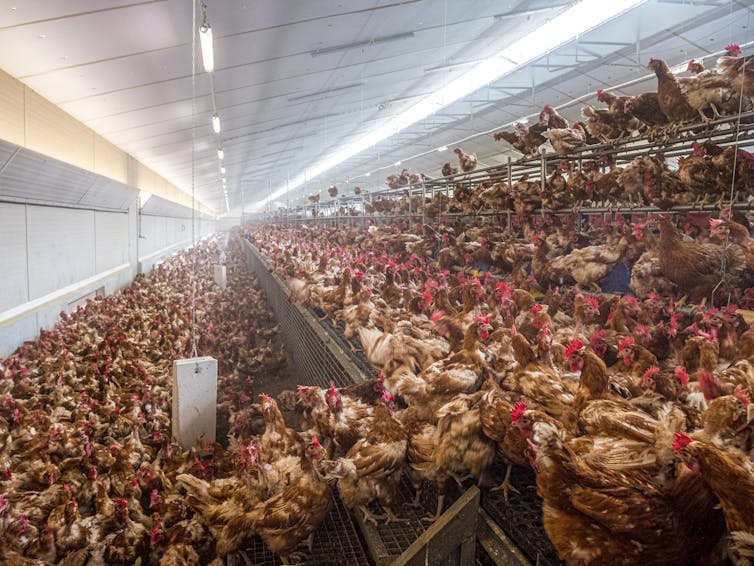
Kayla Bartkowski/Getty Images
Laura E. Alexander, University of Nebraska Omaha
Vice President JD Vance and several bishops of the U.S. Roman Catholic Church are having a war of words over the Trump administration’s flurry of executive orders and highly publicized immigration raids. The bishops argue that these policies tend to empower gangs and traffickers while harming vulnerable families; Vance has criticized the bishops’ stance and argued that crackdowns are a matter of public safety.
In the wake of President Donald Trump’s executive orders, both Archbishop Timothy P. Broglio, president of the U.S. Conference of Catholic Bishops, and Bishop Mark Seitz, chairman of the USCCB’s Committee on Migration, publicly objected to the tone and the humanitarian impacts of the orders.
Seitz critiqued generalizations that denigrate and describe migrants without legal status as “criminals” or “invaders,” saying this “is an affront to God, who has created each of us in his own image.” Instead, he urged humane policies and bipartisan immigration reform for an “effective, orderly immigration system.”
Interviewed on “Face the Nation,” Vance argued that the USCCB should “look in the mirror … and recognize that when they receive over US$100 million to help resettle illegal immigrants, are they worried about humanitarian concerns? Or are they actually worried about their bottom line?”
To be clear, this line of attack appears to be false. USCCB contracts with the U.S. State Department to resettle refugees and has received over $100 million in recent years to do so, but refugee resettlement is a legal immigration program. The Catholic Church, rather than making money on this program, provides funding from its own budget to supplement its humanitarian work with refugees. For example, according to the USCCB’s audited financial statements, in 2023, the most recent year reported, the USCCB spent over $134.2 million on resettlement services. Federal grants provided over $129.6 million for these services, with the USCCB covering the rest.
As a scholar of religion and migration, I see in this debate long-standing tensions among Catholic – and other Christian – thinkers and practitioners about moral obligations to people with whom we have closer versus more distant relationships.
This tension is magnified in the case of migrants without legal status, since most of these migrants do have close relationships with U.S. communities and citizens, but they are not legally authorized by the U.S. government.
2 perspectives on moral responsibility
In international relations, different stances on how to treat people who are not citizens of one’s own state are described as “cosmopolitan” and “communitarian,” respectively.
Some Christian thinkers have adopted these terms as a helpful way to understand Christian ethical debates over how to prioritize caring for people who are more closely connected or less connected to us. Those who take a cosmopolitan stance argue that Christians should care equally about all people of the world and should not show preference to family members or those within their near orbit, even if, for practical reasons, they do assist those close to them more often.
Meanwhile, thinkers who take a communitarian stance argue that Christians certainly should care about the well-being of all but have a moral obligation to prefer helping people they have a closer relationship with, such as family members, those who are close geographically and possibly fellow citizens.
Christian theologies of neighborly love
Many Christian thinkers have developed perspectives on how to prioritize care for different neighbors by interpreting the words and actions of Jesus, as well as the teachings and practices of the early Christian church. Over time, Christian thinkers have also considered institutional statements and traditional teachings of different church bodies.
Early theologians, including Clement of Rome, the first-century bishop of Rome, and John Chrysostom, archbishop of Constantinople in the fourth and fifth centuries, demonstrated cosmopolitan tendencies.

‘Sermon on the Mount’ by Henrik Olrik via Wikimedia Commons
These early church leaders consider biblical passages, including commandments in the Hebrew Bible, to welcome strangers. In the Gospels of the New Testament, Jesus’ parable of the Good Samaritan upholds a person of different ethnicity and religion from Jesus and his followers as an ideal “neighbor.” It also praises acts of kindness across ethnic and religious boundaries.
In another passage, Jesus heals the daughter of a woman who was both non-Jewish and of foreign ethnicity, accepting her chastisement for his initial reluctance to assist a non-Jew.
Later in the New Testament, the apostle Paul used expansive language for the Christian community, particularly in Galatians, the ninth book of the New Testament: “There is no longer Jew or Greek; there is no longer slave or free; there is no longer male and female, for all of you are one in Christ Jesus.”
The contemporary Roman Catholic Church has often taken a cosmopolitan perspective on social issues. Pope Francis, in his message for the 2024 World Day of Migrants and Refugees, highlights the biblical passage that “our citizenship is in heaven” and states that “the encounter with the migrant … ‘is also an encounter with Christ.’”
Catholic service organizations draw on this thinking when they help migrants in concrete ways. In addition to refugee resettlement services, many Catholic organizations provide humanitarian assistance such as food and shelter to migrants, no matter where they are from.
Christian communitarian thought
From a communitarian perspective, some thinkers argue that Christians’ concrete obligations to members of their communities can differ from their obligations to others, even though they view all people as of equal moral worth.
New Testament writings describe how members of early Christian groups provided food and care for those in their communities – even as they also gave charity to the poor in the wider society.
St. Thomas Aquinas, whose writings have also become part of the current debate after Vance referenced them online, argues that Christians should assist people in need, even to the point of depriving themselves of luxuries or social standing. He consistently urges Christians to love all people as commanded by God. Yet he also writes that, all other things being equal, Christians can properly meet the needs of people close to them before they give to those outside their own family or close circles, and that in political matters there can be some justification for preferring fellow citizens.
Some contemporary Christian thinkers apply similar ideas to relationships between citizens and noncitizens in modern states. Ethicist Mark Amstutz argues that American Christian churches should incorporate a stronger focus on citizens’ needs and solidarity within state communities into their statements on immigration. German Catholic thinker Manfred Spieker has advocated that Christian social teachings permit preferences for people one is close to, as well as requirements of cultural integration by immigrants.
These proponents of Christian communitarian perspectives continue to stress that all neighbors should be treated well even if some are prioritized over others. In this way, Vance’s remarks are not the best example of Christian communitarian thought, since migrants without legal status still should not be demonized nor falsely accused of criminal behavior, both of which Vance himself has done in the past few months.
Immigrants in communities and the command to love
Christian thinkers do agree that Christians are commanded by God to show love for all people – those who are like them, those who are not like them and even enemies.
But it’s possible that love could take different shapes in different relationships. Immigration poses a unique test case because immigrants are not citizens, but they are “close” neighbors to U.S. citizens.
Immigrants, including undocumented immigrants, are integral parts of the communities where they live. They work in vital jobs; in 2020-22, 42% of hired farmworkers were migrants without legal status. Immigrants, both with legal status and without, have brought new workers and young families to small towns whose populations have declined in recent decades.
This further nuances debates about cosmopolitan and communitarian moral perspectives, since immigrants arrive from places outside the U.S. but have close relationships with U.S. citizens, whether as family members or as neighbors with whom they work, shop and worship.
At the moment, public debate over immigration reflects trends in U.S. politics as much or more than it does Christian ethics. Yet Christian communities do continue to wrestle with cosmopolitan and communitarian ways of thinking, as they try to understand and apply Christian scriptural and moral commands to care for all people.
Laura E. Alexander, Associate Professor of Religious Studies, University of Nebraska Omaha
This article is republished from The Conversation under a Creative Commons license. Read the original article.





























































